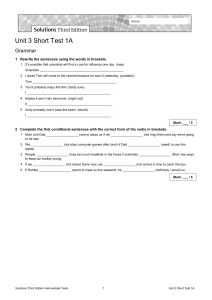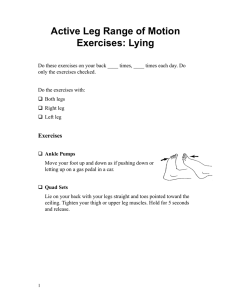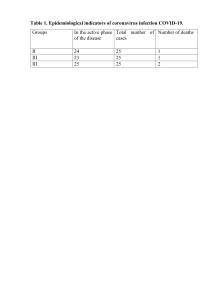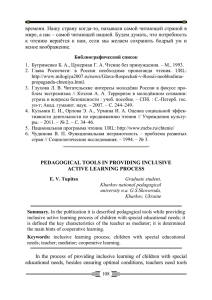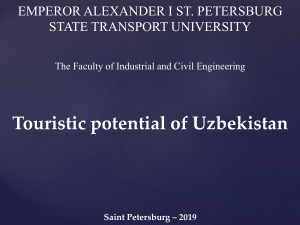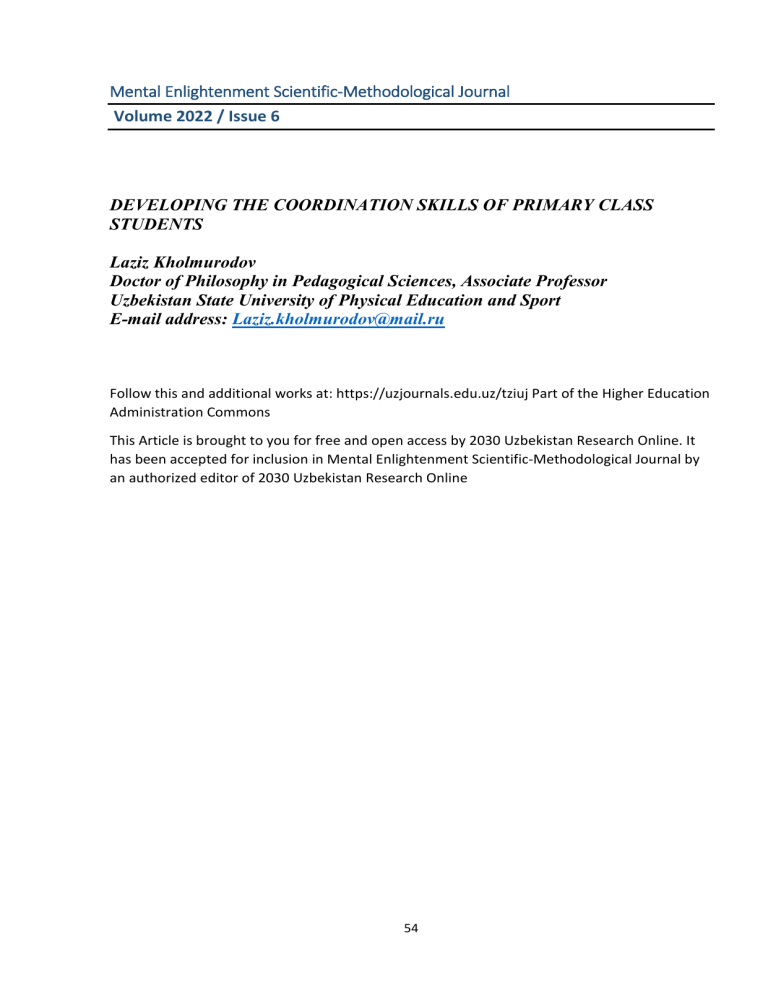
Mental Enlightenment Scientific-Methodological Journal Volume 2022 / Issue 6 DEVELOPING THE COORDINATION SKILLS OF PRIMARY CLASS STUDENTS Laziz Kholmurodov Doctor of Philosophy in Pedagogical Sciences, Associate Professor Uzbekistan State University of Physical Education and Sport E-mail address: Laziz.kholmurodov@mail.ru Follow this and additional works at: https://uzjournals.edu.uz/tziuj Part of the Higher Education Administration Commons This Article is brought to you for free and open access by 2030 Uzbekistan Research Online. It has been accepted for inclusion in Mental Enlightenment Scientific-Methodological Journal by an authorized editor of 2030 Uzbekistan Research Online 54 Mental Enlightenment Scientific-methodological Journal December, 2022, № 6 DEVELOPING THE COORDINATION SKILLS OF PRIMARY CLASS STUDENTS Laziz Kholmurodov Doctor of Philosophy in Pedagogical Sciences, Associate Professor Uzbekistan State University of Physical Education and Sport E-mail address: Laziz.kholmurodov@mail.ru Abstract. This article presents a special set of exercises for the effective organization of the process of physical education of primary school students, the development of the student's coordination abilities, depending on the age and development of physical development and the level of preparedness. Key words: school education, physical development, physical training, coordination abilities, physical activity, education. Actuality. At present, the attention paid to the development of every field in our Republic has reached a political level. Attention was paid to the pedagogical process aimed at fundamental improvement of the school education system, comprehensive intellectual, moral, aesthetic and physical development of children, quality preparation of children for the next stage of education through education and the introduction of modern educational programs and technologies into the educational process. According to the final statistical analysis of 2021, a total of 10,100 schools of general education are operating in our Republic, with 6.3 million students. boys and girls are getting education. Taking into account these data, it is worth emphasizing the importance of effective organization of the process of educational and educational health care, as well as comprehensive protection of the life and health of students of the school educational institution. Decree of the President of the Republic of Uzbekistan dated January 25, 2018 No. PF-5313 "On 55 measures to radically improve the system of general secondary, secondary special and vocational education" and in the implementation of the duties specified in the education of a healthy generation and other regulatory legal documents related to this field this research serves to a certain extent [1,2]. T.S.Usmankhodjaev, A.N.Livitsky, R.S.Salomov, K.M.Makhkamjonov, O.V.Goncharova on the issues of formation and development of basic movement skills and competencies necessary for life in school-aged children; F.Khodzhaev, G.Q. Jalolova, F.A. on the theory of adaptation to health and exercise of elementary school students. The development of ways to develop physical fitness of students in the scientific research conducted by scientists and specialists such as Raimbekova, G.Kh. Salihova remains one of the urgent problems of the theory and practice of physical education today [7,8]. The purpose of the research is to develop the coordination skills of 8-9 year old students with the help of special physical exercises. Tasks of the research work: analysis of scientific and methodical literature on the topic; determination of indicators of physical development and physical fitness of 8-9year-old students in secondary schools; grounding in experience the level of development of coordination abilities of 8-9 year old children using special physical exercises. Research methods: analysis of scientific and methodological literature, pedagogical observation, pedagogical testing, mathematical statistical methods. Organization of research. The experiment was conducted among primary school students (100) of IDUM No. 200 and educational institutions No. 202 in Chilonzor district of Tashkent city. L.P. Matveev, L.I. Penzulaeva, V.I. Lyakh, V.M. Shebeko, T.S. Scientists such as Usmankhodjaev, A.N.Livitsky, R.S.Salomov, K.M.Makhkamjonov have conducted research on this issue in their research. However, as a result of the rapid development of modern theory and practice and the increase in educational 56 requirements, it is necessary to use modern methods to develop the coordination skills of 8-9-year-old children [8,9]. Research results and discussion. Physical activity is a period of formation of vital skills and competencies for a person, especially during childhood and adolescence. Lack of physical activity leads to insufficient development of children's creative activity and coordination skills. Limiting or impairing movement has negative effects at every stage of life. It turned out that a lot of movement is necessary for the growing organism during the primary school period. Physical inactivity causes children to tire quickly, slow down their growth, slow down their mental development, and reduce their ability to fight infectious diseases. Active children have a natural desire for physical and mental improvement. Reasonable use of mental and physical loads is of great importance for the full development of elementary school students. It is advisable to use them widely in planning physical education activities carried out in the daily routine. One of them is to pay attention to the child's physical development from the first school age. The results of indicators of physical development of elementary school students in Tashkent are presented in Table 1. 1 Table Analysis of indicators of physical development of primary school students № Age Тестлар 7 years old 8 years old 9 years old x±δ x±δ x±δ Boys 1 Height (sm) 112,2±0,34 121,4±0,37 129,3±0,56 2 Weight (кg) 17,5±0,17 19,0±0,16 22,4±0,21 3 Claw Strength: 57 4 right hand (kg) 8,0±0,16 10,0±0,19 12,0±0,22 left hand (kg) 6,5±0,18 8,7±0,21 9,3±0,16 At rest 56,0±0,23 61,6±0,42 63,8±0,41 When breathing 57,3±0,25 63,1±0,34 64,5±0,33 Exhalation (cm) 54,4±0,27 60,5±0,29 61,3±0,36 Chest width Girls 1 Height (sm) 113,3±0,25 120,4±0,35 128,2±0,41 2 Weight (кg) 17,3±0,12 20,3±0,5 21,8±0,27 3 Claw Strength: right hand (kg) 5,3±0,18 7,2±0,25 9,3±0,18 left hand (kg) 4,2±0,15 5,3±0,19 8,0±0,21 At rest 56,7±0,7 58,1±0,26 60,1±0,29 When breathing 57,3±0,21 59,8±0,19 62,3±0,13 Exhalation (cm) 55,4±0,11 57,3±0,22 58,8±0,33 4 Chest width In order to determine the initial level of development of coordination skills in elementary school students who participated in the pedagogical experiment, the studied indicators were tested. As a result of this test, children were divided into control and experimental groups. So that the average group results of the control and experimental groups do not have statistically significant differences, each group was formed with 10 people using the pair sampling method. The results of sled running and Romberg control tests were analyzed. The obtained results are presented in Table 2. Table 2 Analysis of comparative results of control and experimental group students at the beginning of the study Control exercises Groups 58 Statistical indicators Romberg control test, sm Shuttle run, s x±δ t Р ТГ 10,2±0,6 0,4 ≥0,05 НГ 9,9±0,5 ТГ 11,8±0,1 0,7 ≥0,05 The results presented in the table above allow us to emphasize that the average of the studied indicators and the initial development of their coordination abilities in the groups are at the same level. The mean indicated that the differences were not statistically significant. The following types of running can be used in training with children of this age: slow and fast, in place, running in a circle, running along a snake trail, around objects (signs), holding hands, running in pairs. Children learn complex tasks together with the teacher: running with the hips up (in place and moving forward), running alternately in pairs, threes, etc. to the designated place in all directions. The simplest jumps in form are standing on two legs, moving forward, backward and sideways, as well as turning 90 degrees to the left and right. Then half-sitting and sitting jumps. The next stage of training is hopping from foot to foot, in place and in motion. In addition, it is possible to learn combinations of jumping with one leg forward and the other backward in a position with the legs open and together. Performing jumps on one leg, the other can bend back or straighten forward to the side, but no more than 4 jumps in a row. Jumps to the right, left, forward and back are a bit difficult; jump up by touching the target hanging at different heights; double jumping (in place and with movement) with an object fixed between the knees or legs, as well as jumping to and from heights. Physical fitness and development of children is the main component of health. The physical development of children and the quality of training depends on the pedagogical correctness of the physical education process using modern methods and forms. 59 Based on this, we have prepared the following balancing exercises for students' coordination skills. 1) Stand on one leg facing the gymnastic wall forward, sideways or backward, or put on 2-3 rails of the gymnastic wall and balance in different positions of the hand. 2) I.s. - initial standing. 1-2- standing on the right leg, bending the left leg forward (toes touch the knee of the left leg), arms raised up; 3-4 balance; 5-6lowering the leg, etc.; 7-8 rest. Then perform the exercise with the other leg. 3) I.s. - initial standing. 1-2- right leg 45 degrees back, hands to the sides, body in a vertical position, slightly leaning forward with the chest; 3-4maintaining balance; 5-6- lowering the legs, etc.; 7-8 rest. Perform the exercise with the other leg. 4) I.s. - initial standing. 1-2- bend the right leg back and grab the tip of the leg with the right hand, in front of the left hand; 3-6- maintaining balance; 7-8 lowering the legs, etc.; Perform the exercise with the other leg. Table 3 Analysis of the comparative results of control and experimental group students at the end of the study Control exercises Romberg control test, sm Shuttle run, s Groups Statistical indicators x±δ t Р ТГ 17,6±0,5 6,4 ≤0,05 НГ 12,3±0,7 ТГ 11,2±0,3 3,2 ≤0,05 At the end of the pedagogical study, a final control test was conducted. Table 3 shows the dynamics of changes in indicators of development of coordination skills in elementary school students during pedagogical experience. 60 Diagram 1. At the end of the study, changes in the results of the shuttle run control exercise, s. The group mean improved from 11.8 seconds to 11.2 seconds, a statistically significant difference in results, a change of 0.6 seconds. During the same period, students in the control group also recorded a positive change in results from 11.7 seconds to 11.5 seconds. But in this case, the changes are less significant - 0.2 seconds (see diagram 1). Diagr am 2. At the end of the study, the change in results in the "Romberg" control test, s. The students of the experimental group showed high positive changes according to the results of the control exercise "Romberg test" shown in diagram 2. 61 The result improved from 10.2 s to 17.6 s with statistically significant differences in the experimental group (the result improved by 7.5 s). The results of the control group changed from 9.9 s to 12.3 s (an improvement of 2.4 s). Positive changes were noted in both groups, but it was observed that they were higher in the students of the experimental group. Thus, the conducted pedagogical research allows us to conclude that the experimental methodology developed using gymnastic tools allows to more effectively increase the level of development of coordination skills in elementary school students. The inclusion of national games (10-30%) and competitive game styles in the physical education process of children of preschool educational institutions helped to arouse children's interest in training, increase their general physical fitness, and strengthen the acquisition of program materials. According to the results of the final test, our study made it possible to obtain the following results of the development of coordination skills. It was found that students in the experimental group improved their running performance by 0.6 seconds, which is 5.1%, and in the control group, it increased by 0.2 seconds, which is 0.9%. In the Romberg control test, the result of the students of the experimental group improved from 10.2 seconds to 17.6 seconds with statistically significant differences (the result improved to 7.5 seconds). The results of the control group students changed from 9.9 seconds to 12.3 seconds (the result improved to 2.4 seconds). The conducted pedagogical experience allows us to conclude that the experimental methodology developed using gymnastic tools (walking, running, jumping, basic movement and balance exercises) allows to more effectively increase the level of development of coordination skills in elementary school students. REFERENCES: 62 [1]. Law of the Republic of Uzbekistan "On Physical Education and Sports" (new edition), September 5, 2015. [2]. Decree of the President of the Republic of Uzbekistan "On measures to fundamentally improve the system of general secondary, secondary special and vocational education". No. PF-5313 of January 25, 2018 [3]. Kholmurodov L. Z. Development of physical qualities of preschool children //Fan-Sportga. – 2021. – no. 1. – S. 46-49. [4]. Kholmurodov L. Z. Development of physical abilities and technical-tactical training of young football players in relation to their age //Fan-Sportga. – 2021. – no. 3. - S. 8-10. [5]. Kholmurodov L. Z. Development of coordination abilities in preschool children using special physical exercises //BBK 75.1 A-437. - 2019. - S. 655. [6]. Kholmurodov L. Z. Development of children's ability to maintain static balance //Fan-cportga. - 2019. - No. 4. - p. 2-6. [7]. Lyakh V. I. Development of coordination abilities in preschoolers. ed., "Sport" - M.: 2016. - 96 p. [8]. Usmonkhajayev T.S., Islamova S.T. Physical education in preschool educational institutions T.: "Ilm Ziya" publication. 2006. - 184 p. 63

